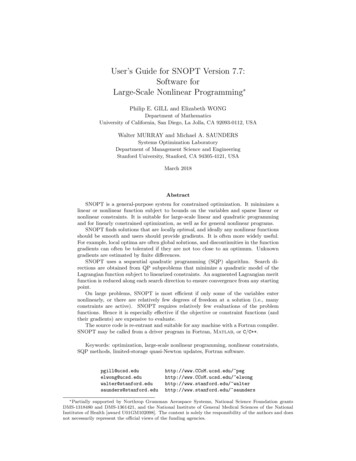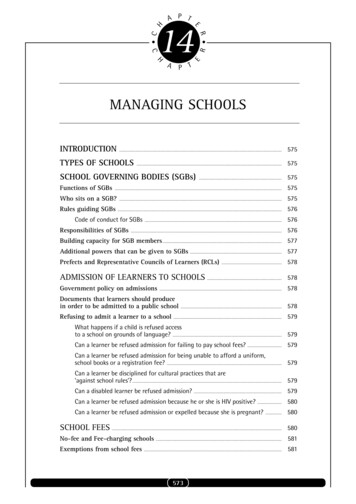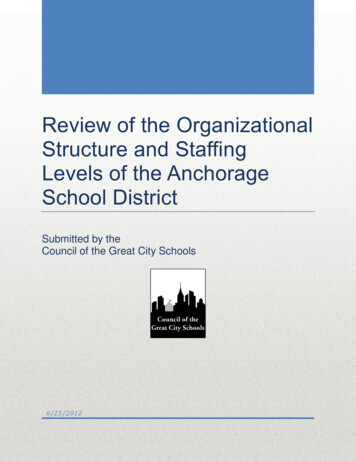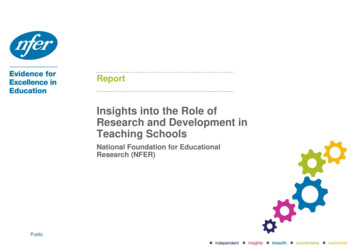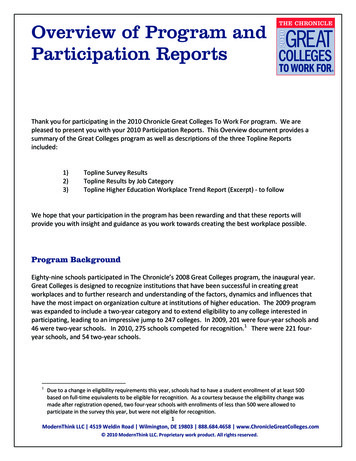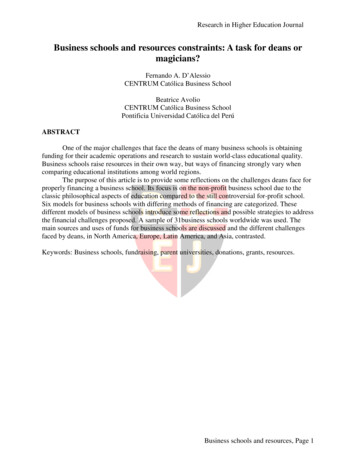
Transcription
Research in Higher Education JournalBusiness schools and resources constraints: A task for deans ormagicians?Fernando A. D’AlessioCENTRUM Católica Business SchoolBeatrice AvolioCENTRUM Católica Business SchoolPontificia Universidad Católica del PerúABSTRACTOne of the major challenges that face the deans of many business schools is obtainingfunding for their academic operations and research to sustain world-class educational quality.Business schools raise resources in their own way, but ways of financing strongly vary whencomparing educational institutions among world regions.The purpose of this article is to provide some reflections on the challenges deans face forproperly financing a business school. Its focus is on the non-profit business school due to theclassic philosophical aspects of education compared to the still controversial for-profit school.Six models for business schools with differing methods of financing are categorized. Thesedifferent models of business schools introduce some reflections and possible strategies to addressthe financial challenges proposed. A sample of 31business schools worldwide was used. Themain sources and uses of funds for business schools are discussed and the different challengesfaced by deans, in North America, Europe, Latin America, and Asia, contrasted.Keywords: Business schools, fundraising, parent universities, donations, grants, resources.Business schools and resources, Page 1
Research in Higher Education JournalINTRODUCTIONBusiness schools have existed for 100 years, but the institutional, national, andinternational crises the world has faced in recent years have given them a more important roletoday than ever before. Emblematic cases such as ENRON, Parmalat, World.com, and thecollapse of other private sector companies, have brought attention to the grooming ofprofessionals in MBA programs and its relevance to these fiascos.The globalization of the economy following the fall of the Berlin Wall has led thetrustees and deans of business schools to question: (a) whether the curricular structure of theirMBA programs is sufficiently innovative for this global economy and whether their programsprovide students with a proper balance between hard and soft skills; (b) the relevance of thecostly and lengthy research being conducted; (c) the hiring of costly, and largely unproductive,faculty members seeking tenure; (d) the building of modern facilities required to deliver theirprograms; (e) the high maintenance costs of buildings for executive education programs; (f) thecostly staff required to support academic and administrative activities; (g) the growingoperational expenses and enormous fixed costs to be leveraged; and (h) the compliance with thePrinciples for Responsible Management Education (PRME) to craft global responsible leadersaccording to the UN Global Compact (2007).The competitive arena generated by the global economy is obliging deans to be creative,especially by expanding their schools operations into new markets to make their growthsustainable. Business schools competition is becoming global; deans attempt to attract highcaliber students into their programs; accreditations are costly in resources to be allocated;obtaining accreditations is crucial to successfully compete; and rankings play sometimes a role inthe applicants’ decision-making process. There is a wide range of existing business schools tolook over. A few questions are posed to develop this essay.The first question is: What is a business school? AACSB International (2010) claimedthat there are 12,087 business schools in the world, but they range from tiny, minusculedepartments inside universities in developing countries to renowned schools such as HarvardBusiness School (Boston), IE (Madrid), LBS (London), INSEAD (France) and IMD (Lausanne),and increasingly competitive regional schools such as FDC (Nova Lima), IAE (Buenos Aires),Universidad del Desarrollo (Santiago), CENTRUM Católica (Lima), Insper (Rio de Janeiro), andINCAE (San José). These latter are rapidly becoming important players in this competitiveglobal arena, many of which are financially independent schools.The second question is: What are the major constituents of a high-quality businessschool? (a) Faculty is number one. The size of the faculty is related to the number of students. Acombination of academically and professionally qualified, participating and supporting, and coreand non-core faculty is required, as is a mix of full-time, part-time, affiliated, visiting and partnerschool professors. (b) Teaching quality. Professors possessing a combination of theoretical andpractical business capabilities are required to enhance students’ knowledge, skills, and attitudesduring their formation. (c) Power to convene. This is crucial to attract academics and businesses,society and governmental leaders to their programs and activities such as conferences, symposiaand forums. (d) Students. The number of students defined in the strategic objectives of differentprograms: degree and non-degree students, combining young, middle-aged and seniorexperienced. How many and what type of students? These are related to the school’s fundingsources. (e) Research. Pure and applied research or both. Research aimed at gaining ormaintaining accreditations, rankings and recognition. Contributions to knowledge and practice.Business schools and resources, Page 2
Research in Higher Education Journal(f) Facilities. On-campus and off-campus accommodations; modest, good, or outstanding. Aproper balance of physical and technological facilities is indispensible. These depend on the sizeof the student body and to the face-to-face or virtual programs delivered by the school. (g)Support services. For academic, administrative, placement, lodging, security, cleaning, food, aswell as other services related to the size of the student body.A third question that follows is: How do these schools finance their operations forgrowth? Reasonably, having sufficient financial resources can culminate in a high-qualitybusiness school being developed and becoming a place where future leaders are groomed to leadimportant and successful national and global organizations towards the common good. There area broad range of types of business schools, from the stand-alone fully tuition-driven schools tothose that are fully-dependent on a parent university.A fourth question concerns the location of the business school: should it be a singlelocation or a multi-location school? If it is multi-location, should it be within and/or outside thenational borders and, if within, in one or in multiple locations? There are important differencesamong the world’s different regional residencies of the schools’ programs. Four regions areconsidered: North America (United States and Canada), Latin America (from Mexico south),Europe (Western Europe) and Asia (Asian business schools are relative newcomers).A fifth question concerns the scope of the business school. Will it offer (a) degreeprograms (undergraduate and/or masters and/or doctoral programs); and/or (b) non-degreeprograms (executive education, certificate programs, in-company, and/or consulting). Businessschools focus their academic operations on graduate education, mainly MBAs and executiveeducational programs. Doctoral programs are star programs, but they are costly to manage due totheir academic complexity and the difficulty in financing them.These questions pose the constraints in financing a business school. Business schoolsleaders require well-developed sources and uses of finances. The purpose of this article is toreflect on the challenges deans face in properly financing a business school so that they arecompetitive in the global arena and achieve recognized accreditation and favorable positions inreliable business school rankings. Provided the still controversial nature of for-profit education,non-profit business schools will be the primary focus of this article.The search for financial resources to cover operational costs and support research effortsis an ongoing challenge for most business schools deans. The traditional model of accomplishingthis task solely from student tuition is insufficient to meet today’s global market demands andenables a school to become a global player. Sources of financing are not abundant, and it is notan easy task to access them. It is an especially complicated task for business schools deans incountries where there is no culture of giving and where there are few public incentives. Thisprocess is even more difficult for those schools that are attempting to compete with businessschools with financing models such as those in the United States and Europe. For example, in theUnited States, in addition to the funds generated by the schools themselves, schools have accessto donations; an important per cent of business school resources come from donations, whetherfrom individuals, corporations or foundations. In Europe, in addition to donations, there is aculture of public funding for schools.While the cultural factor is crucial to donations, no less important is the factor oftaxation, which in some cases discourages philanthropic initiatives. In many countries, nolegislation exists to promote donations, but rather, legislation may restrict donations.How then can a business school dean diversify a school’s sources of funding and achievehigh international recognition via accreditations and rankings? All business schools in the worldBusiness schools and resources, Page 3
Research in Higher Education Journalface challenges with respect to increasing their financial resources, however, some businessschools have a greater disadvantage in obtaining the necessary resources to finance high-qualityeducation and support exceptional research. Finally, what makes a business school great may bethe bottom line for any dean and financial resources may be the most important means to achievethat goal.SOURCES OF FUNDS AND THE FINANCING OF BUSINESS SCHOOLSBusiness schools have a variety of ways to generate revenue and finance their operations.Revenue generation falls into five categories as shown in Figure 1 (Appendix): (a) resourcesgenerated by the business school’s programs and services; (b) resources provided by the parentuniversity; (c) resources granted by government or multilateral organizations; (d) resourcesprovided by private donations, endowments, grants, and gifts; and (e) a combination of theprevious categories.Resources Generated by the Business SchoolResources generated by a business school are those that it receives from students andother stakeholders through the provision of services. The resources consist primarily of tuitionfor educational services, as well as the sale of publications, patents, copyrights, advisoryservices, merchandising and, for some business schools, other services such as consulting orapplied research. Traditionally, revenue generated by tuition payments for degree programs,executive education programs, or customized programs developed for the particular needs ofcompanies have been the cornerstone and in many cases, the only sources of income, of businessschools.Although most business schools generate a significant proportion of their resourcesthrough student payments for degree and executive education programs, top-tier businessschools, especially in the United States, have been able to diversify revenue generation increative ways. These include the staggering sale of journals, case studies, books, magazines,newsletters, and other publications, in print or e-format, as well as the sale of the rights for theuse of other publications.Harvard Business School (HBS) is an icon and provides a benchmark in this sense. Forexample, the HBS financing model (HBS, 2009) has been to disseminate intellectual capitalproduced by the faculty through executive education programs through its Harvard BusinessSchool Publishing unit. In 2009, Harvard Business School generated 29% of its revenue frompublications such as the Harvard Business Review, the sale of articles from its collection, and thesale of cases and books. Executive education programs generated 23% of HBS’s revenues. Thesale of these offerings typically generated more than 50% of the HBS’s total annual revenue,enabling the HBS to advance the practice of management. Completing the cycle, contributionsfrom Harvard Business School Publishing (HBSP) and executive education programs serve asthe mainstay source of support for its faculty’s research.The MIT Sloan School of Management, which produces important revenue from the saleof publications such as the MIT Sloan Management Review, is another interesting example.Likewise, the Stanford Graduate School of Business generates revenues through the StanfordBusiness Magazine, and the London Business School publishes a business magazine calledBusiness Strategy Review, purchased directly or by subscription through Blackwell Synergy.Business schools and resources, Page 4
Research in Higher Education JournalResearch is part of the knowledge-and-revenue productive chain for top-tier businessschools. Research, often conducted in different foreign centers, has permitted the HBS togenerate content for its journals, case studies, articles, and books. These publications act as animportant engine for the generation of revenue from consulting. In general, research atuniversities and business schools in the United States has been strengthened by legislation suchas the Bayh-Dole Act of 1980 (University and Small Business Patent Procedures Act), whichpermits universities to partake from the output of their research. The Bayh-Dole Act permitsuniversities, academic research laboratories, and educational institutions to protect as intellectualproperty the research carried out by their own or with public funds through patents.Royalties are collected by universities, and the new funds generated permit continuedresearch, entering into a virtuous circle that underpins the research industry at universities in theUnited States (Council on Governmental Relations, 2010). Consulting and advisory services forpublic and/or private institutions and the sale of patents, copyrights, and technical reports arepotential sources of revenue from which business schools can benefit if proper mechanisms andprocedures are established, and if business schools achieve sufficient dynamism to sustain thegeneration of income.Additional means of generating income include the sale of promotional merchandisefrom business schools, such as briefcases, agendas, T-shirts, sweatshirts, gift certificates, and soforth; the collection of funds coming from room and board facilities; and the rental of facilitiesfor events, seminars, conventions, and conferences. The sale of merchandise also promotes theinstitution’s brand and creates ties between business schools and the communities they serve.Resources Provided by the Parent UniversitySome business schools are created as independent units of a university, and some opt forand are granted autonomy after sufficient income is generated. However, most business schoolsoperate as strategic business units of the universities that initiated the business school andmaintain relationships with the parent university. This is true of Harvard University and theHBS, the University of Navarra and the IESE, the Tecnológico de Monterrey and the EGADE,Oxford University and the Saïd Business School, Cornell University and the Samuel CurtisJohnson Graduate School of Management, Michigan University and the Stephen M. Ross Schoolof Management. Similarly, New York University and the Stern School of Business are affiliatedas are MIT and the Sloan School, Northwestern University and the Kellogg School, theUniversity of Virginia and the Darden School of Business, Universidad Austral and IAE, and thePontificia Universidad Católica del Perú and CENTRUM Católica. The university may providefunds for the establishment of a business school and support it until the school can generate theeconomic resources necessary to ensure its independent operations and future expansion. Most ofthese business schools have their facilities inside the university’s main campus, while othershave independent facilities that may be far away from the main campus.Most often, resources are provided during the first years of operation, and the school usesthe resources to buy assets or to finance the construction of a campus and other requiredbuildings and facilities. They subsequently begin to pay a royalty to the university as retributionto its founder and for the use of its name. Thus, the establishment of a business school can beunderstood as the formation of a new strategic business unit that, in the medium- and long-run,will repay the financial resources provided by the university at its beginning.Business schools and resources, Page 5
Research in Higher Education JournalThe most common relationship of a business school to its parent university is that it ispart of the university, either as a department of business administration or as a business school,with the same facilities in the university’s main campus and financial dependence on the parentuniversity. This is the case of the Facultad de Administración [Department of BusinessAdministration] of the Universidad de los Andes in Bogota, the Department of BusinessAdministration of the Universidad de Chile in Santiago, and the Department of BusinessAdministration of the ITAM in Mexico D.F. Most of the business schools in the United Statesare a constituent part of the parent university and depend on the president and board of trusteesfor the allocation of financial resources to operate and conduct research. Business school deansare also fundraisers, but after funds are received, they are administered by the president of theparent university.There is a small group of business schools that do not belong to any university and arestand-alone educational units. This is the case of Fundação Dom Cabral (Nova Lima, Brazil),INCAE (San Jose, Costa Rica), EADA (Barcelona), IE (Madrid), Audencia (Nantes, France),INSEAD (Fontainebleu, France), IMD (Lausanne, Switzerland) and IESA (Caracas, Venezuela),among others.Resources Granted by the Government and Multilateral OrganizationsSome governments provide financial resources directly to universities and businessschools as part of their policy to improve the quality of education. Government funds are mostoften directed to public business schools that use the resources to cover a significant portion oftheir annual budgets. Depending on the country, public funds may come from the central orfederal government, the state government, and/or the local or municipal governments.According to the U.S. Department of Education (2008), in the United States, the federalgovernment provided US 19.8 billion in resources to public higher education institutions in2000, 48% more than that given to private higher education institutions. The most significantdifference, however, lies in the contributions given by the individual state governments that, inthe same year, provided US 62.9 billion to public higher education institutions and US 1.15billion to private schools.In Europe the picture is more varied. Three groups of countries received different typesand amounts of government aid, as indicated by Godenir, Delhaxhe, and Deutsch (1999). In thefirst group, which included Denmark, Greece, Luxembourg, Austria, Finland, and Sweden, bothpublic and private educational institutions were funded in full with resources from public sectorentities; they did not receive funds from tuition fees. In the second group, public and privateinstitutions operated under the same conditions, receiving grants from the government, and alsoable to receive private funds by charging tuition fees. This was the situation in the UnitedKingdom (UK), where higher education institutions received significant private funds, some ofwhich were generated by charging tuition fees; and in Belgium and The Netherlands, where feeswere similar in both public-sector and private grant-aided institutions. The third group includedGermany, Spain, France, Ireland, Italy, Portugal, Iceland, and Liechtenstein, in which publicfunds went mainly or entirely to publicly-administered institutions, while privately administeredinstitutions were financed primarily through private funding. In France and Iceland, publicinstitutions charged relatively low registration fees, whereas private institutions charged muchhigher tuition fees despite their receiving government grants. In Spain and Portugal, privateinstitutions did not receive government funds directly, but were favored indirectly, but to a lesserBusiness schools and resources, Page 6
Research in Higher Education Journalextent, by subsidies given to students to cover their tuition payments. In Italy, the autonomy ofinstitutions in financial matters has made possible a substantial increase in tuition fees at publicinstitutions, but the student contribution to the budget of public universities could not exceed20% of the funds provided by the government (Godenir et al., 1999).These three groups do not operate the same way today. European Union countries financetheir education expenses through two types of funding: public funding (87.5%) and privatefunding (12.5%). On average, these countries spend 1.1% of GDP for higher education, withDenmark (2.3%) and Norway (2.1%) being the countries that spend the most on research(Ranguelov et al., 2009).The picture is more austere in Latin America in terms of state funding, Brazil being aspecial case. Educational institutions in Latin America attempt to follow the European model.Public funds, if available, go exclusively to publicly administered institutions, and privatelyadministered institutions are financed exclusively through private funding. Isolated cases exist ofgovernment contributions in the form of scholarships, research grants to students, or support forresearch, but the amounts are small and have no major impact on the funding of the institutions.In terms of the percentage of gross domestic product (GDP) spent by government on education,Brazil (3.9%), Chile (6.4%), and Mexico (6.45%) are among the Latin American countries listedin Education at a Glance (Organisation for Economic Cooperation and Development [OECD],2007). Only Chile and Mexico have private investment in education that is close to thepercentage of GDP allocated to higher education (5.8% of GDP).Brazil has developed a model that promotes research and postgraduate studies, supportingthese activities with institutions such as the Coordination for the Improvement of HigherEducation (CAPES) and the National Council for Scientific and Technological Development(CNPq), through which funds are awarded according to the productivity of the institutions thatapply. CAPES plays a primary role in evaluating and certifying graduate programs, providingprograms with resources based on the institution’s performance in the evaluation of the qualityof graduate academic programs, and it may shut down those programs that do not meet itsstandards (CAPES, 2010).In Mexico, most resources are aimed at improving the quality of education. Institutionssuch as the Fund for the Modernization of Higher Education (FOMES) provide funds forresearch projects and seed capital to start-up Mexican educational programs, and the Program forthe Improvement of Teaching Staff (PROMEP) is used to train teachers and develop skills toenhance teachers’ performances. The amount of funding, however, is minimal when compared tothe funding provided in the United States or Europe (Undersecretary for Higher Education inMexico, 2010).Some governments in developing countries receive contributions from bilateralinternational development agencies. Agencies such as the Japan International CooperationAgency (JICA), the Spanish Agency for International Development Cooperation (AECID), theCanadian International Development Agency (CIDA), and the German Academic ExchangeService (DAAD), play limited but critical roles in promoting research in the countries where theyoperate. These agencies provide resources to business school students and researchers from theirown budgets or channel resources through the scholarship programs of non-governmentalorganizations in their own countries. Other examples are the Carolina Foundation of Spain,Erasmusfriends from the Madrid Community in Spain, the Alexander Von Humboldt Foundationof Germany, and the Ford Foundation in the United States.Business schools and resources, Page 7
Research in Higher Education JournalFinancing by multilateral organizations refers to the resources provided by internationallending institutions with a regional and/or global reach, such as the Inter-American DevelopmentBank (IDB), the Andean Development Corporation (ADC), the International Monetary Fund(IMF), and the World Bank (WB). Funds are managed similarly to the bilateral internationaldevelopment agencies. Fellowships are given directly to researchers or students of a particularsocial or academic community to continue studying. Students choose the school, and theagencies finance their studies.Resources Provided by DonationsDonations may take the form of grants, endowments or gifts, and are a way for businessschools to attain resources. Each of these forms of donations has specific characteristics, frombenefactors and beneficiaries to tax incentives. Donations are given to non-profit organizationsto support ongoing work that meets the objectives and goals of the donor organization.Donations to business schools may be in the form of cash, goods, and other property given forreasons of altruism or a desire to collaborate with the institution. They permit business schools torecruit top faculty from around the world, conduct research, provide scholarships and fellowshipsfor outstanding students, for remodeling and improving facilities, and for incorporating newtechnologies. Private entities include donations from non-profit institutions, foundations, andcompanies such as the Ford Foundation and the Konrad Adenauer Foundation, as well ascompanies such as the Banco Santander of Spain and the like.Individual donations are an important source of revenue for most business schools in theUnited States, but are less so in other countries. In order for donations to constitute a steadysource of funding, two elements must converge: culture and incentive. In this regard, Zúñiga(2005) noted the following:Donation is deeply rooted in American culture since the days of Andrew Carnegie, whowith the 'gospel of wealth', laid the foundations of the philanthropic spirit that sustainsdonations to higher education in the United States: found a university, establish freelibraries, create medical research laboratories or centers, create public parks, providerooms for meetings and concerts, establish public swimming pools, and help churches,especially those in poor communities. Carnegie, Rockefeller, and others introduced whatis now known as the philanthropic foundation, and professionalized it through therecruitment and training of personnel specialized in fund management. But it was notuntil the organization of events and campaigns to collect funds that improved results wereobtained from the efficient use of volunteer efforts to procure funds. It was thus alsoattractive to private enterprise, which could now more easily link itself to its community,actively participating through its contributions, thus generating a positive image for thecompany in its environment. (p. 11)Individual donors, including philanthropists, celebrities, notable and recognizedindividuals, provide grants to non-profit institutions, while donations are also provided by alumniand people who have some affiliation with the school. Some examples include MichaelBloomberg of Bloomberg L.P., an HBS alumnus, who in 1996 endowed US 3 million for theWilliam Henry Bloomberg Professorship at HBS. Other examples include Eli and Edyth Broad,who provided Philanthropic donations to the Eli Broad College of Business and the Waltons ofWal-Mart Stores, Inc., who donated to the Sam Walton M. College of Business. A special case isthat of W. P. Carey, who donated US 50 million in 2002 to Arizona State University and theBusiness schools and resources, Page 8
Research in Higher Education Journalsame amount to Johns Hopkins University in 2006 to attach his name to these well-knownbusiness schools (Johns Hopkins University, 2006).Individual giving in the United States is the largest component of charitable contributionsand in 2008 was estimated at US 229.28 billion, or 75% of the total giving. In the same year,charitable bequests were estimated to be 7% of total giving, corporate giving was estimated toequal 5% of all charitable giving, and foundation grants were estimated to be 13% of the total(GivingUSA Foundation, 2009). The same source reported that total giving in the United Stateswas US 307.65 billion in 2007, from which 13% (US 40.94 billion) went to education.Individual donations play an important part and are often the most widely publicized. Leovy(2000) gave an account of the donations made by Max Palevsky, a well-known art collector,investor, and director emeritus of Intel Corp., who gave US 20 million to the University ofChicago to raise the quality of life in the student’s dormitories on the university campus. CentralEuropean University (2001) mentioned in its newsletter that George Soros, internationalfinancier and investor as well as philanthropist, spent US 200 million in 2005 on the creation ofthe Central European University in his native Hungary, and he is a regular donor to thatuniversity. Stanford University News Service (2006) reported the 2006 donation of US 105million by Phil Knight, founder and CEO of Nike, who had already donated several times to theUniversity of Oregon and to build the
professionals in MBA programs and its relevance to these fiascos. The globalization of the economy following the fall of the Berlin Wall has led the trustees and deans of business schools to question: (a) whether the curricular structure of their MBA programs is sufficiently innovative for this global economy and whether their programs


